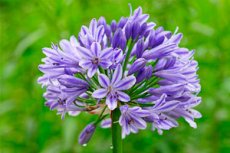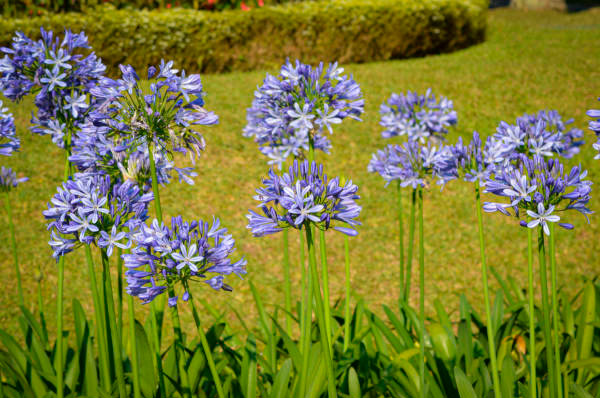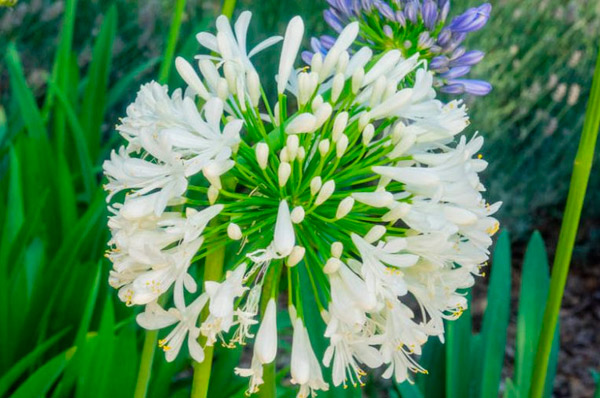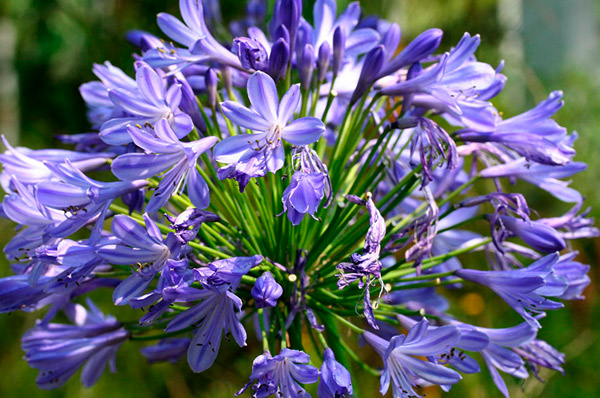New publications
Plants
Agapanthus
Last reviewed: 11.03.2025

Agapanthus (Latin: Agapanthus) is a herbaceous perennial plant widely known for its striking flower clusters in the shape of balls or umbels. Its blue, purple, or white flowers form large rosettes, rising on tall flower stems above the lance-shaped leaves. Due to its prolonged flowering period and relative ease of care, Agapanthus has become widely popular in both garden and indoor horticulture.
Etymology of the name
The name "Agapanthus" is derived from the Greek words agape (love) and anthos (flower), which can be literally interpreted as "flower of love." In botanical tradition, this name was established due to the elegant appearance of its inflorescences and their association with beauty and harmony.
Life form
Agapanthus is typically considered a rhizomatous or bulbous herbaceous perennial (more precisely, a plant with rhizomes, which are sometimes mistakenly referred to as bulbs). Its roots and underground organs are adapted to store moisture and nutrients, allowing the plant to endure dry periods.
In certain climates, particularly those with mild winters, Agapanthus can grow outdoors as a garden perennial. In colder regions, it is often grown in containers or indoors to protect it from extreme temperatures and to ensure stable growth conditions.
Family
Agapanthus was previously included in the lily family (Liliaceae) or the amaryllis family (Amaryllidaceae), but modern taxonomy often places it in its own family, Agapanthaceae. This family includes several species that share similar morphological traits, such as flower structure and type of rhizomes.
The Agapanthaceae family is relatively small and does not contain a large variety of genera. Agapanthus is the most well-known and widely cultivated member, as most other plants in the family are only found in the wild.
Botanical characteristics
Agapanthus has lance-shaped or linear leaves that form a basal rosette. The inflorescences, which are either umbels or spherical heads, are located on tall flower stems that can reach 50–100 cm or more in height. The flowers are tubular, usually blue or purple, sometimes white. The fruit is a three-chambered capsule containing flat black seeds.

Agapanthus africanus
Chemical composition
The chemical composition of Agapanthus includes various organic acids, sugars, and flavonoids that contribute to the vibrant color of the flowers. Some studies suggest the presence of saponins and alkaloid compounds in the stems and leaves, although their concentrations are low. Toxic compounds in Agapanthus are scarce, making the plant relatively safe when basic precautions are followed.
Origin
Agapanthus is native to South Africa, where it grows in areas with a mild climate and alternating wet and relatively dry periods. It is found in natural habitats such as meadows, hillside slopes, and near water bodies, which explains its ability to withstand short droughts and temperature fluctuations.
Initially, Agapanthus attracted the attention of botanists and gardeners traveling through Africa, and was later introduced to Europe and other parts of the world. Over time, the plant became widely popular as an ornamental species, especially in greenhouses and private gardens.
Ease of growing
Agapanthus is considered relatively easy to grow as long as a few basic conditions are met: it requires good lighting, moderate but regular watering, and a rest period with lowered temperatures. The plant is fairly resilient to the mistakes of beginner gardeners but may show reduced flowering if care is not consistent.
Difficulties may arise in regions with harsh winters, where special preparation for the cold season is necessary. Growing in containers makes wintering easier by allowing the plant to be moved to more favorable conditions.
Species and varieties
Several species of Agapanthus exist, with Agapanthus africanus, Agapanthus praecox, and Agapanthus orientalis being the most common. Numerous cultivars and hybrids have also been developed, differing in height, flower color (ranging from pure white to dark blue), leaf shape, and flowering duration.

Agapanthus orientalis
Size
In its natural habitat, Agapanthus can reach 1–1.5 meters in height, with flower stems rising above the rosette of leaves. In cultivation, the plant’s growth often depends on the pot size and growing conditions, but the average height usually ranges from 60–90 cm.
The bush diameter can vary from 30 to 60 cm, depending on the variety. Under favorable conditions, it eventually forms a dense clump, which can be divided and transplanted if desired.
Growth rate
Agapanthus develops at a moderate pace. During the spring-summer period, with sufficient heat, light, and moisture, it actively increases its leaf mass and sets flower buds.
In less favorable conditions (lack of light, cold, or soil drying out), the growth rate slows down, and the plant may enter a semi-dormant state, retaining only a limited number of leaves.
Lifespan
With proper care, Agapanthus is considered a long-lived perennial. A single plant can retain its decorative value for over 10–15 years, forming an increasing number of rosettes.
A slight reduction in lifespan may occur if the plant faces stressful conditions (nutrient deficiencies, chilling, or regular drying out). However, even in such cases, Agapanthus can live for several years without significant loss of vitality.
Temperature
The optimal temperature range for active growth is 18–25 °C. During flowering, small temperature fluctuations (up to 28–30 °C during the day and around 15–18 °C at night) do not harm the plant but help stimulate flowering.
In winter, the plant prefers cool conditions (around 10–15 °C), which allows it to enter a phase of relative dormancy. At temperatures below 5 °C, the rhizomes may be damaged, and at sub-zero temperatures, Agapanthus often dies without proper protection.
Humidity
Agapanthus tolerates moderate humidity levels (40–60%) relatively well, which is typical for most heated indoor environments. Additional spraying of the leaves can be beneficial in very dry conditions but is not strictly necessary.
Excess moisture with poor ventilation can promote fungal diseases on the leaves and roots. Therefore, it is important to maintain a balance and provide adequate, but not excessive, humidity levels.
Lighting and room placement
Agapanthus prefers bright light, including direct morning or evening sunlight. The optimal placement is on an east or west-facing window, where the plant receives enough sunlight without being exposed to midday sunburn.
In conditions of insufficient light (north-facing windows, shading from buildings), growth and flowering will significantly deteriorate. If grown in rooms with limited light access, additional lighting from phytolamps may be required.
Soil and substrate
A light, fertile mixture is suitable for Agapanthus, consisting of approximately 40% garden or sod soil, 30% peat, 20% coarse sand or perlite, and 10% leaf mold or compost. This structure ensures good drainage and air permeability while retaining sufficient moisture for the roots.
The recommended soil acidity is in the range of pH 5.5–6.5. A drainage layer at the bottom of the pot (expanded clay, small gravel) is essential to prevent water stagnation and root rot.
Watering (summer and winter)
In summer, Agapanthus should be watered abundantly and regularly, keeping the substrate moist but not waterlogged. During heatwaves, watering may be required 2–3 times a week, but ensure that the top layer of soil dries slightly between waterings.
In winter, especially if the plant is kept at lower temperatures (10–15 °C), watering should be reduced to once every 2–3 weeks. During dormancy, the rhizomes do not require excessive moisture, and overwatering can lead to rot.
Fertilizing and feeding
Agapanthus responds well to complex mineral fertilizers applied every 2–3 weeks from spring to late summer. Compositions with higher levels of phosphorus and potassium are especially effective in promoting flower bud development.
It is convenient to alternate root fertilization with foliar sprays using weaker fertilizer solutions. It is important not to exceed the recommended doses to avoid root burn or salt buildup in the soil.
Flowering
Agapanthus usually begins flowering in mid- to late summer, with the process lasting 3–5 weeks depending on the conditions. Numerous buds gradually open on long flower stems, giving the plant a striking appearance.
To stimulate repeat or more abundant flowering, it is recommended to create small stress situations at the end of autumn—reduce watering and lower the temperature, simulating "winter dormancy." After returning to the regular care routine in spring, Agapanthus will actively form new flower stems.

Agapanthus praecox
Propagation
The simplest method of propagating Agapanthus is by dividing the rhizomes or separating side rosettes during repotting. The best time for this is early spring when the plant is still in a state of relative dormancy. The separated parts are planted in separate pots with prepared substrate.
It is also possible to propagate by seed, though it takes longer to grow new plants, and seedlings may differ in appearance from the parent forms. Seeds are sown in a light mixture of peat and sand, maintaining moderate humidity and a temperature around 20–22 °C.
Seasonal features
During the spring and summer, Agapanthus is in an active growth and flowering phase. It requires more light, moisture, and nutrients during this time. It is important to ensure sufficient watering and regular fertilization.
In autumn, the plant gradually prepares for winter dormancy: as the temperature decreases and daylight shortens, watering can be reduced. In winter, there may be complete or partial dieback of the above-ground leaves (depending on the species), which is normal and should not cause concern.
Care features
When caring for Agapanthus, it is important not to allow prolonged water stagnation at the roots, as this can quickly lead to rot. Regularly inspecting the leaves and flower stems allows for timely detection of diseases or pests.
The plant responds well to the changing seasons with a rest period: if it is allowed to "rest" in winter, it will form large and healthy flower stems in spring.
Home care
The first important point is choosing the right location with adequate lighting. Agapanthus should be placed near south, east, or west-facing windows with diffused light. If necessary, use blinds or light curtains for shading at noon.
The second aspect is maintaining regular but moderate watering: during the warm months, the soil should remain slightly moist but not waterlogged. In winter, watering is drastically reduced. It is helpful to monitor humidity by checking the top layer of substrate before each watering.
The third point is fertilization: during active growth (from March to August), fertilize every 2–3 weeks, alternating mineral fertilizers with organic ones (e.g., a weak biogum solution). It is important not to overfeed with nitrogen to avoid excessive leaf growth at the expense of flowering.
Finally, temperature and periodic rest should be taken into account. If it is not possible to lower the temperature in the room during winter, the plant may retain its leaves, but flowering may be less abundant. In this case, additional measures such as ventilation or placing the pot near a cool window are recommended.
Repotting
The choice of pot depends on the size of the root system: if the roots are tightly packed in the substrate and protrude from the drainage holes, it is time to increase the pot diameter by 2–3 cm. An excessively large pot is undesirable because the plant will direct its energy toward occupying the new soil volume instead of flowering.
Repotting is best done in spring before Agapanthus enters the active growth phase. If necessary, the bush can be divided at this time. After repotting, the plant should be kept in partial shade for a few days, with watering reduced until the roots take hold.
Pruning and crown shaping
Typically, Agapanthus does not require special pruning to form its crown, as the leaf rosette naturally grows quite symmetrically. Only spent flower stems and dry or damaged leaves are removed to maintain aesthetic appeal and prevent fungal infections.
Some species, under good conditions, form quite large bushes, and in such cases, the number of leaf rosettes can be regulated by dividing the rhizomes, which also rejuvenates the plant.
Possible problems and solutions
Overwatering or improper watering can lead to root rot, which manifests as wilted leaves, loss of turgidity, and rotting at the base. Solution: dry the substrate, treat the roots with fungicides if necessary, and adjust the watering regimen.
Nutrient deficiencies result in pale leaves, slow growth, and sparse flowering. Regular feeding with balanced fertilizers can correct the situation. Care mistakes, such as lack of dormancy, can lead to the absence of flower stems.
Pests
The main pests attacking Agapanthus are aphids, spider mites, and thrips, which prefer succulent leaves and may settle on the underside of the leaf blades. Their appearance is often associated with increased air dryness or crowded plant placement.
Prevention includes regular inspections, spraying with warm water, and creating favorable humidity. In case of a heavy infestation, chemical insecticides or biopesticides should be used according to the instructions, ensuring that the recommended doses are not exceeded.
Air purification
Like many plants with large leaf surfaces, Agapanthus can partially purify the air from volatile organic compounds and increase humidity through evaporation. While its contribution to creating a healthy microclimate is not large, the plant can become part of an overall home or office greening system.
Regularly wiping the leaves of dust enhances photosynthesis and improves the plant’s air filtration efficiency. This is especially relevant in urban apartments with poor outdoor air quality.
Safety
Most species of Agapanthus are not considered toxic to humans; however, the sap from the leaves or stems can cause mild irritation to mucous membranes and skin in particularly sensitive individuals. It is advisable to wear gloves when working with rhizomes or dividing the bush to avoid contact with the sap.
Allergic reactions are rare but can occur in individuals with sensitivities. If redness or itching develops, wash the affected area with water and consult a specialist if necessary.
Wintering
In regions with a warm climate, Agapanthus can winter outdoors if temperatures do not fall below 0 °C or briefly drop below this level. In colder conditions, the plant is dug up or moved into containers and placed in a room with a temperature of 10–15 °C.
During wintering, watering is significantly reduced, and feeding is stopped. Some species shed part of their leaves, entering dormancy. In spring, Agapanthus is returned to a warmer location, and regular watering and fertilizing are gradually resumed.
Beneficial properties
In addition to its aesthetic value, Agapanthus is known for its flowers, which are rich in vitamin C and antioxidants. Eating fresh slices or drinking Agapanthus juice helps strengthen the immune system and improve digestion.
The refreshing effect is
Noted when Agapanthus fruits are added to drinks or salads. The sour taste is due to organic acids, which, in moderate amounts, are beneficial to health, but care should be taken with certain gastrointestinal conditions.
Use in traditional medicine or folk remedies
In some African regions, Agapanthus was used in folk medicine, with leaf infusions to reduce fever and as an adjunct treatment for colds. However, these methods have not received widespread scientific validation, and the potential irritating effects of the sap should be kept in mind.
The use of plant parts internally (such as the leaves) should be done with caution, as the chemical composition is not fully studied, and some components may cause allergies or gastrointestinal disorders.
Use in landscape design
Thanks to its bright flowers and lush leaf rosettes, Agapanthus is often planted in groupings, flowerbeds, and borders, creating vibrant color accents. The plant looks great along garden paths or near water features, emphasizing the tropical aesthetic of the area.
Vertical gardens and hanging compositions with Agapanthus are less common due to its large root system and hefty flower stems. However, in spacious pots or hanging containers, striking exotic accents can be created if adequate support and care are provided.
Compatibility with other plants
Agapanthus pairs well with other sun-loving herbaceous perennials such as geraniums, daylilies, and irises. Its blue or purple flowers often create a harmonious contrast with the yellow or white flowers of neighboring plants.
When combining in compositions, the height of Agapanthus and its growth habit should be considered: the plant may slightly overshadow shorter species. It is recommended to plant it toward the back or center of the bed or flower border, leaving space for its growth.
Conclusion
Agapanthus is an attractive and relatively easy-to-care-for plant that can beautify both interiors and garden spaces when basic care requirements are followed. Its expressive inflorescences, reminiscent of umbels or spheres, become a central decorative element, attracting admiration and interest from onlookers.
Proper placement, maintaining the right humidity and watering regime, and paying attention to the rest period help achieve abundant and regular flowering. Agapanthus can delight its owner with its beauty for many years, harmoniously complementing plant compositions and creating a cozy and private atmosphere.
